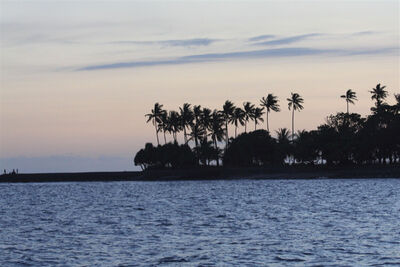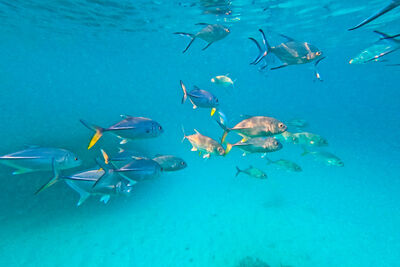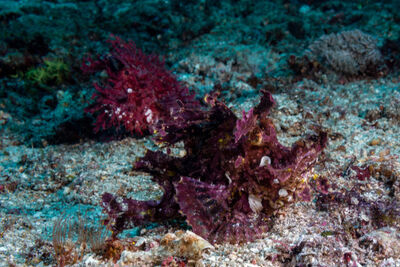Sitting within the Coral Triangle, the Bali Sea laps the northern shores of both Bali and Lombok and flows into the channels that separate the two islands from each other and their neighbours. Its warm and inviting waters are home to a rich variety of marine life, and the dive sites in the area have something for all divers: shallow reefs for the less experienced or beginners; colourful reefs for photographers; weird and wonderful critters for muck divers; sharks, turtles and large rays for fans of ocean giants; and one of the world's most famous wreck dives just a stone's throw from the beach. The balmy Bali Sea dive sites are awash with diverse marine life and an array of colours, and if you head below the surface at the sea's southern extremes, you'll encounter the mola mola and manta rays that the cooler Indian Ocean currents entice to the reefs. This small body of tropical sea is a mecca for sun-seekers and scuba divers alike, so let's dive in and discover some fascinating facts about the Bali Sea...

1. The Bali Sea extends far beyond Bali
Where exactly is the Bali Sea? There's a huge clue in the name, but the full extent of the Bali Sea goes some way beyond the waters surrounding Indonesia's Island of the Gods. The International Hydrographic Organisation (IHO) describes the Bali Sea's northern boundary as extending from the northeastern point of Java, up and across to the south of the Kangean Islands, then east to the Tengah Islands and down past Moyo Island to the coast of Sumbawa, near Utan. The Bali Sea also encompasses the three straits that separate Java, Bali, Lombok and Sumbawa, and its southern boundary cuts across from the southeastern corner of Java, past the southern tips of Bali, Nusa Penida and Lombok's south coast, to the southwestern corner of Sumbawa.

2. The Indonesian Throughflow passes through the Bali Sea
The Indonesian Throughflow is an important oceanic current that carries water from the Pacific Ocean through the southern Philippine Sea and the Indonesian archipelago to the Indian Ocean. This current plays a major role in regulating temperatures in the region, and it passes through the Bali Sea, and much of it is squeezed through the Bali Strait, Lombok Strait and Alas Strait. This flow of water is also part of the reason the Bali Sea's dive sites are home to such colourful corals and diverse marine life, so we are big fans of this particular Bali Sea fact.

3. The Bali Sea sits on the Pacific Ring of Fire
The Bali Sea may not have officially been the inspiration behind the huge Johnny Cash hit, Ring of Fire, but the Bali Sea does sit on the Pacific Ring of Fire, so who knows? If you want to take in some stunning vistas across the Bali Sea, there are some awe-inspiring volcano climbs waiting to welcome you and your hiking boots. Mount Batur and Mount Agung provide perfect hiking opportunities for non-dive days (we'd recommend dawn hikes so you can watch the sunrise from the summit), in between dives around some of Bali's northern sites (a couple of our favourites being the USAT Liberty wreck and Seraya Secrets in Tulamben). While across the Lombok Strait, Lombok Island is home to the second-highest volcano in Indonesia: Mount Rinjani.

4. The Bali Sea is renowned for its muck diving
Muck diving enthusiasts and avid macro photographers will be happy to know they can while away many an hour under the Bali Sea. Sitting at the top of the Bali Strait, near Gilimanuk, is a world-renowned dive site that is somewhat ironically known as Secret Bay. It may once have been a secret, as it's slightly off Bali's main tourist trail, but its muck diving is so good that it was never going to stay secret for long. Critters such as frogfish, ghost pipefish and harlequin shrimp can all be spotted, and if you venture in for a night dive, you may even spot a Bobbit worm.
Another great spot for macro photography is Seraya Secrets. You can find all the usual muck diving suspects here, with plenty of frogfish, mantis shrimp and seahorses. There's even the chance of a mimic octopus sighting! As an added bonus, the volcanic black sand provides a great contrast to the vivid colours of the corals and the cryptic critters.

5. The Bali Sea is one of the best places in the word to see mola mola
At its southern extreme, the Bali Sea meets the cooler currents of the vast Indian Ocean. This helps make the diving around Nusa Penida, just off Bali's south coast, pretty epic. It's well regarded as the world's premier dive site for seeing the elusive mola mola, or oceanic sunfish. These bizarre-looking fish look somewhat incomplete, like a swimming head, but they can measure up to two metres in length and three metres from fin tip to fin tip. Crystal Bay is arguably the best dive site for mola mola, and if you also fancy watching some giant manta rays being cleaned, Manta Point is just around the corner (and seldom disappoints on the big ray front!).
And those cool Indian Ocean currents we mentioned also help great white sharks travel between South Africa and Australia, which explains why one was spotted at Crystal Bay a few years ago!

6. There is some iconic wreck diving in the Bali Sea
Back in the Bali's Sea's northern dive sites, you can find one of the most famous and accessible wreck dives on the planet. The USAT Liberty was a United States Army cargo ship that served in WWII. While navigating the Bali Sea, she was torpedoed by the Imperial Japanese Navy and was forced to run aground on the beach at Tulamben. Fast-forward almost twenty years, and Mount Agung's volcanic grumblings and expulsions rocked the boat back into the ocean. The wreck now lies a very short distance from the shore and is an exceptional wreck dive. Non-divers can also snorkel the shallow sections of the dive site, making it suitable for all.
The wreck is encrusted with kaleidoscopic corals, set against dark, volcanic sand, and it is home to a plethora of prettily coloured marine life. Frogfish, pygmy seahorses, a full spectrum of nudis and ghost pipefish can all be spotted, while black-tipped reef sharks are also quite common. Dawn or dusk dives can reward divers with the sight of the resident bumphead parrotfish leaving the wreck or returning to it to sleep. If you promise to be quiet and not wake them, a night dive on the wreck is also a special experience...
















